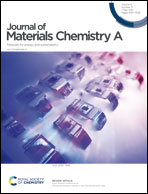Novel core–shell structured MgH2/AlH3@CNT nanocomposites with extremely high dehydriding–rehydriding properties derived from nanoconfinement†
Abstract
In this work, a simple and efficient nanoconfinement method is developed to construct a novel “core–shell” structured MgH2/AlH3@CNT nanocomposite (MgH2/AlH3@CNTs). CNTs with a high specific surface area (550 m2 g−1) and a small diameter (approximately 6–8 nm) contribute to finer crystal size (60–80 nm) of the core–shell structured MgH2/AlH3@CNT nanoparticles. Owing to the special “core–shell” structure, this nanocomposite shows significantly better H2 de- and absorption thermodynamics and kinetics. The composite releases H2 at ∼71 °C, which is substantially below the temperatures observed for the MgH2, nano-AlH3, and other MgH2/AlH3 composites. It also shows dramatically improved dehydriding and rehydriding kinetics, rapidly releasing 8.20 wt% H2 in 1 h at 200 °C and taking up 5.61 wt% H2 in 0.16 h at 250 °C. During dehydrogenation and rehydrogenation, the CNTs can effectively prevent the aggregation of the nanocomposite particles and enhance the MgH2 and AlH3 direct contact. Thus, the application of these noteworthy core–shell MgH2/AlH3@CNTs offers a very promising way to improve the kinetics of the nanoconfinement system.



 Please wait while we load your content...
Please wait while we load your content...